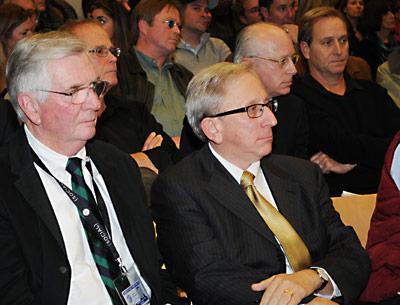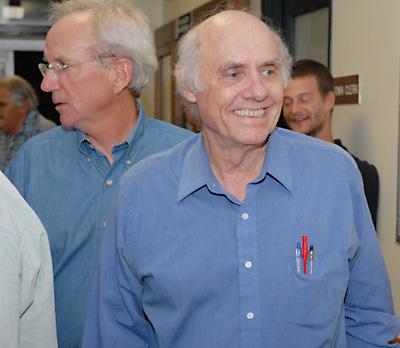Fish Tales, Bent Rods, Doubleheaders
Fish Tales, Bent Rods, Doubleheaders

When well told, a fish story is a love sonnet that begins with “There we were” in place of “Shall I compare thee to a summer’s day?” and ends when a beautiful creature is brought up from the deep to babbling praise along the lines of “So long as men can breathe, or eyes can see / So long lives this, and this gives life to thee.”
If the crew aboard the Viking Star on Tuesday has anything to say about it — and you can bet they will — the day they were attacked by an army of black sea bass will not be forgotten.
The Viking Star was a floating book of sonnets as it left its dock in the dark two days after Christmas with a crew of Montauk locals, longtime friends, fishermen to a man — except for Joe Bloecker’s daughter, Fallon.
The fishermen sat around the table across from the small coffee-and-egg-sandwich factory that is Kobi’s galley, and, as waves slapped the Starship’s steel hull en route to Coxes Ledge they spun yarns enough for a heavy sweater.
Jack Curtin, who drives a tugboat in New York Harbor these days, brought them back to the day he was a hundred miles at sea in February. He had fallen from a longliner while going after a big tilefish that slipped from his hands as he unhooked it. The fish was floating on the surface.
“I didn’t feel the cold at first. I swam after it, away from the boat. He made me fall and I wanted to get him.”
“I yelled, ‘What the hell are you doing?’ ” Eddie Eurell recalled.
“He pulled me out,” Curtin said of Eurell, his former crewmate nodding. Both laughed at the scary memory.
And, there was the time it took several men to haul Big Paul out of the harbor when he fell from a plank between dock and boat. He weighed 450 pounds. Then there was the time a bayman who was expert at such things skinned a big green eel by making a few cuts at the head and peeling it off the body like a stocking, then giving it to another bayman (they all knew him and smiled), who wore it as a headband while playing the slots at the Foxwoods casino. The band stayed fresh — for a while.
And there was the big striped bass caught on six-pound test in the freshwater of Hook Pond, where the striper should not have been. Was there a way into the pond from the ocean? There used to be, years ago. Scallops were discussed, and how fishing regulations were turning good men into criminals. And, the one about the fisherman who stayed at sea because the I.R.S., a motorcycle gang, an ex-wife, and the police were all looking for him. Where else could he go? Nowhere, they all agreed.
On and on they flowed, fish stories powering this particular trip as much as the Starship’s growling diesel.
Capt. Steven Forsberg actually did compare Tuesday’s trip to a summer’s day in that the grounds east and southeast in 90 feet of unseasonable, 51-degree water were carpeted with dinner plate-size porgies and sea bass and had been since September.
Captain Forsberg settled on a favorite bottom structure at Coxes Ledge just as the sun drew a thin red line to mark the horizon. A heaping pile of skimmer clam baits awaited the hooks of Jack Curtain, Eddie Eurell, Joe Bloecker, Ritchie Weiss, Charlie Etzel, Stuart Heath, Sean Kinney, Bill Modica, Gil Parker, and Ray Hackebill, a young local on his first offshore trip.
The first drop yielded a scary number of dogfish, the bane of many a fishing trip, but then several nice cod appeared, then sea bass, bergall, and porgies. When the Star moved to a second spot, a pollock was caught, and later in the day, a Spanish mackerel, a few bluefish, and a monkfish. Thirteen species in all, a bountiful mix that included many fish that should have been long gone. A pod of dolphins approached in arcing strides at one point. Shearwaters banked off wave-face updrafts. Mother Carey’s chickens, petrels, skittered along the surface.
The weather forecasted for the following day appeared ahead of schedule. The breeze stiffened, the sky blackened, and a white-capped ocean swell grew out of the southwest, as did the fish story in the making.
Between drops the fishermen repaired to Kobi’s galley or caught some shut-eye. When clam-baited fishing lines were sent below once again, their trepidations were read by knowing hands. Joe Bloecker told Ray Hackebill how the line’s vibration would telegraph the difference between a nibble and a bite. “Don’t swing at the small ones,” Bloecker told him. “Save it for the big ones.”
The sun couldn’t tell you, but it was noon when Captain Forsberg turned the Star west toward a spot south of Block Island. After an hour’s steam, the island was just visible to the north, and it was getting late. The Star settled on some numbers the captain knew well. The screen of his electronic fish finder showed a stretch of fish — years of experience told him they were sea bass — in vivid, living color.
Stuart Heath and Gil Parker took up position toward the bow on the starboard side with most of the other locals forming a phalanx along the rail. The boat was anchored and Captain Forsberg gave the signal. Baits descended to the bottom but the fish did not allow them to linger. Rods bent immediately and stayed bent for nearly an hour. Sea bass were coming over the rail in waves, their fins and spines erect, gills flared, electric turquoise stripes ablaze.
At first, one fish at a time was brought up on the two-hook terminal gear. Then the anglers learned to wait a beat to feel the second hook taken. Arm-weary anglers began reeling up “doubleheaders.” Coolers bulged. Captain Forsberg grabbed his rod and joined the action.
A story was being written in the grins, the hoots and hollers of friends who shared a strong bond with their hometown’s ocean surroundings. Stuart Heath summed up the day, so long as men can breathe, or eyes can see: “Black gold!” he shouted, lifting a doubleheader over the rail. “Black gold!”







